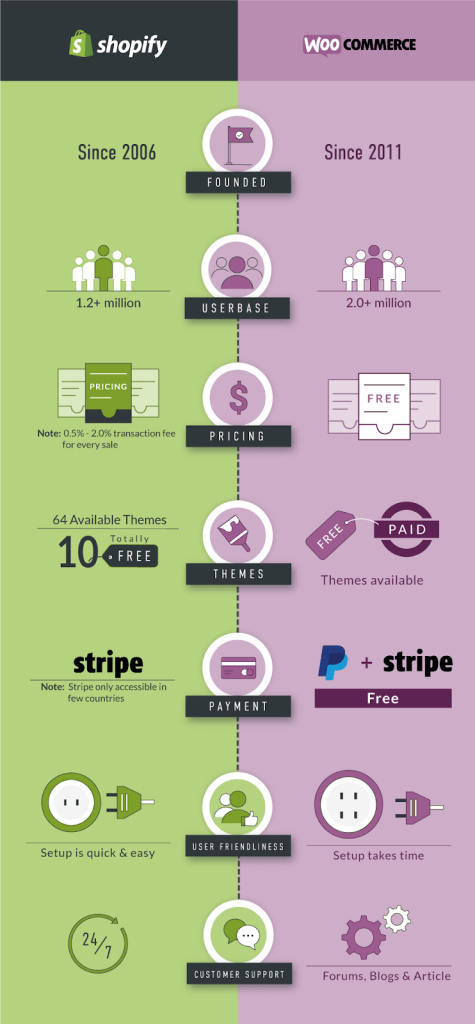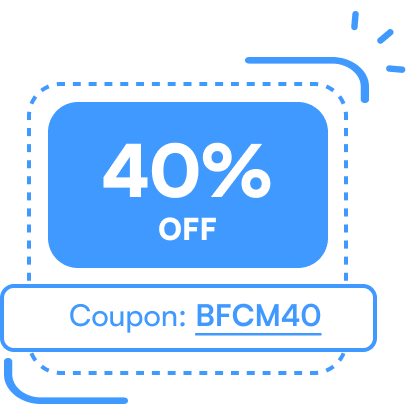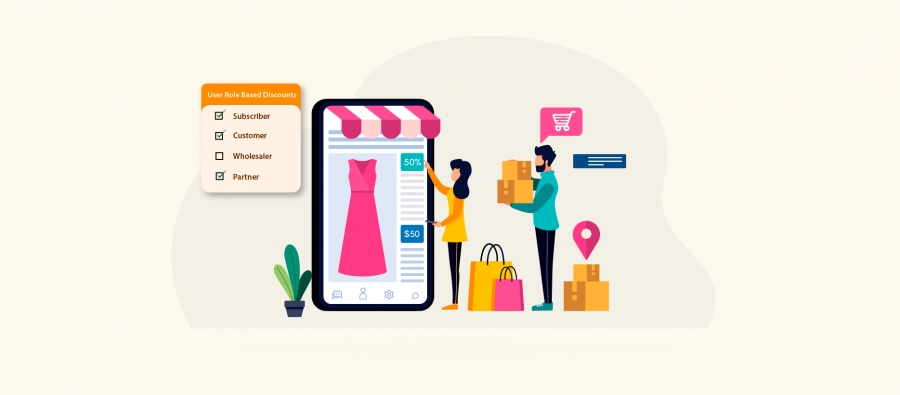WooCommerce or Shopify? If you are looking for an eCommerce solution, you must have already started your eCommerce quest. Don’t get mega-lo-phobic on seeing the big eCommerce picture. We’ve always got your back!
Both Shopify and WooCommerce are the two most popular eCommerce platforms. So, there are few things we need to prioritize before choosing between Shopify and WooCommerce.
It’s always good to talk on the basics of any topic in the first place before discussing it’s detailed picture.
What is Shopify?
Shopify is a Canadian based eCommerce company which made its existence in 2006. Be it anything with eCommerce- hosting websites, selling products, receiving payments, inventory management, everything can be done with ease using Shopify. Wanna know the number of active Shopify stores. It’s 1.2 million and more. The largest industry on Shopify is fashion and apparel. So folks if fashion your business niche, Shopify is one good place to kick-start your brand.
What is WooCommerce?
WordPress + eCommerce = WooCommerce
Knowing a little about WordPress will help in knowing WooCommerce better. WordPress is an open-sourced Content Management System that helps to build websites. Nearly 30.6% of the total websites on the on internet functions with WordPress. It’s definitely got some potential and its evident from the stats and numbers.
Okay. WordPress is massive in content sharing platform. Will it help me to sell online? How can I use it in my online business model? WooCommerce answers it all.
WooCommerce is an open source eCommerce plugin designed for WordPress and powers nearly 42% of all online stores. It allows you to build an online store with the most powerful and simple Content Management System( WordPress). Featuring many extensions and customizing options, there is no doubt about WooCommerce being the biggest eCommerce platform.
How to build an eCommerce store?
Before getting started with the setting up of an eCommerce website we need to make sure to tick some important checkboxes.
- Planning the budget for the complete set up your online store is the most essential thing to do.
- Don’t try doing things the hard way. The management of the online store should be with ease. How easy is my eCommerce store to manage is the second checkbox.
- An online store needs the support of many third-party integrations for efficiency with payments and other services. So choosing an eCommerce platform which offers maximum extensibility is recommended.
Online Buyer Persona
E-Commerce is all about making customer engagement simple. Let’s derive some insights from this personal scenario. How does my eCommerce shopping happen?
- Stage 1 – I enter the store’s website only after seeing the theme and design features of the homepage.
- Stage 2 – When the product and contents are extensive, I stay online to shop.
- Stage 3 – Finally, expect my shopping to end easily without any hassle in the payments and checkout page.
My 3 stages in eCommerce shopping also reflect the common online shopper’s persona. So let’s discuss on these primary buyer factors and then look at some of the backend features as well.
1.Themes and Design- WooCommerce Vs Shopify
Are books judged by their cover? Sorry about the Cliche. But the answer is definitely a Yes. Most often looks make judgments. Especially when it comes to eCommerce stores, the look of the store is the only available feature to show the professionalism of a brand.
Shopify themes
Look Sells First!
When it comes to the quality of design and themes for your eCommerce store Shopify scores a home run. Shopify seems to offer a total of 64 well-designed store themes out of which 10 are free. Shopify theme prices range between $140- $180. Each Shopify theme offers a minimum of two styles and a maximum of four style variations. So that makes the count more than 100 when we speak about Shopify theme styles.
The Shopify themes are designed by professional developers and so the themes are always available update.
Never worry about the store going offline if you are launching a new product because Shopify allows you to update the changes easily. Get your hands to do the coding and customize your store themes personally with Shopify’s ‘Liquid’. Liquid is the language used to design Shopify themes.
On Shopify, you can also detect what other websites’ themes are (using tools like shopthemedetector , and if you like them, you can install them on your own shop.
WooCommerce Themes
Look Good to Sell Good!
Do you know that WooCommerce is developed by WooThemes? Why are we speaking on this now? Because WooThemes is the theme developer for WordPress sites. So when it comes to Woo themes and design of your store, it can work with your WordPress themes. If you are just beginning with your store then it is good to go with the official WooCommerce theme- Storefront. Also WooCommerce is build to support many themes in the market and if you are looking for specific design features the web has many plugins specifically for WooCommerce. The only thing that may be a concern is that not all the WooCommerce themes are free. But unlike Shopify, the theme choices aren’t limited with WooCommerce.
2.Content and Features
ECommerce isn’t just about selling products and receiving payments. As an eCommerce store, we need to deal with maintaining stocks (inventory management) orders, payments, shipping rates, discounts, coupons, offers, email customization, etc.
Both WooCommerce and Shopify offers plenty of plugins and add-ons for your store to make selling better. And most times even eCommerce stores need some contents for marketing. If your store takes content marketing seriously, then WooCommerce can be your pick as it’s of WordPress. Apart from the usual eCommerce features, this particular feature of Shopify grabbed my attention. With the help of shipping app for Shopify, you store can be more automated in the shipping process, making it easier and faster for businesses to get their products to their customers.
Shopify POS is a special application with which you can link your offline store with Shopify. So you can sell products anywhere in the market, store, offices and receive payments anywhere. Do you got an Android or Apple device? The payments and purchase receipts can be done with both.
3.Payment options with WooCommerce and Shopify
What makes the eCommerce shopping complete? Payments. The customer needs to be provided with a safe and secure payment gateway to make their shopping experience complete.
With Shopify, customers can make payments via Stripe– its default payment option. Shopify also supports other payment gateways like PayPal and Amazon payments for credit card payers. The major shortcoming with Shopify payments is that its default payments are available only with few countries. United States, United Kingdom, Canada and Australia are the countries supported with default payment gateway. For rest of the countries, third party payment gateways need to be purchased. Definitely, an addition to the budget!
With WooCommerce, payments won’t be an issue as there is plenty of payment gateways in store. The best payment services- PayPal and Stripe are completely free with Woo. Also, we can purchase and add other payments plugins as well to our WooCommerce store if wanting to use specific additional benefits.
4.Hosting
Have you got the website designed? Got the brand name and logo sketched? What’s to be done next? Doesn’t it need to be hosted? Website hosting is must to make our online store live on the internet. Website hosting services hold responsibility for the functionality of website during peak web traffic.
Choose Shopify and forget about hosting. Because Shopify allows hosting of your website on its own servers. See What! Shopify even provides you with unlimited storage facility for your website. Website hosting is definitely Shopify’s biggest advantage.
It’ll be numb if we say hosting is tough with WooCommerce. We need to choose our hosting services when it comes to WooCommerce. Hosting can be seen both as a pro and con of Woo. Because the pro is that we can decide the hosting servers based on our preferences. Con- Hosting adds to our budget with Woo. Make sure to choose the hosting service that offers good Storage size, processor, bandwidth because eCommerce drives can see heavy traffic.
5.WooCommerce pricing and Shopify pricing
The final decision made between WooCommerce and Shopify will be decided with pricing. Pricing turns out to be the deciding factor. Whatever be the features and services offered by both WooCommerce and Shopify, it must fit under our eCommerce budget.
WordPress is an open source plugin- free but it needs to be hosted. So hosting the eCommerce store will be the first expense in the chart. Then we need to decide on all the additional features and plugins must for the store to calculate Woo’s pricing.
Now with Shopify, we are provided with 3 available plans. The basic plan starts at $29, intermediate at $79 and advanced Shopify will cost $299. Do remember that Shopify also charges 0.5% to 2% as a transaction fee for every sale we make. This will be the kind of hidden pricing with Shopify. Get doing some math and see which in both WooCommerce or Shopify is feasible with your budget.
6.Which is user-friendly? WooCommerce or Shopify
How easy is the store to set up? How easy is to manage the store are the two factors considered to determine the user-friendliness of these eCommerce platforms.
What if we just need to click a button to set up the eCommerce store. Would be quite Impressive. Since Shopify is a subscription-based tool, we just need to visit Shopify.com, Click Sign up tab and after that few setup steps. That’s it. The store is online. Shopify even guides us through each and every process in making the online store complete.
If you are with WordPress already, WooCommerce will not need an user-dictionary. Both WordPress and WooCommerce can get a bit slow to start with but once when we get used to the Woo dashboard, it’s easy to navigate all the features.
7.Marketing elements
You would have surely heard talks on Search Engine Optimization- The continuous buzz around the eCommerce industry. SEO is the organic way (without spending on ads) to rank our store at the top of the Google’s search page.
Search engine optimization with WooCommerce
WooCommerce is basically with WordPress and WordPress is all about content creation. So, SEO features are covered with Woo. In Fact experts consider WooCommerce to be the most reliable when it comes to SEO. Be it content editing, metadata everything can be done with ease and you fancy chances to make it to first result page using keywords.
SEO in Shopify
SEO is surely not the best feature of Shopify. But it handles the SEO basics like meta information and site copy with ease. Since built on a huge infrastructure, the speed of the loading pages are quick. Shopify is fast!
8.Shopify Customer Support and WooCommerce Support
Support is one important feature that is expected from any service. Every one of us needs support and expertise many times whenever we use any product or service.
- Good that you paid to purchase the Shopify account. With Shopify the availability of customer support is round the clock- 24/7. We can get an expert solution from the support team anytime. Support is accessible through email, chat and voice calls. Shopify also provides with an extensive documentation on commonly asked queries.
- WooCommerce doesn’t have a direct customer support base. As you know WooCommerce is a free plugin, we can get the support from WordPress forums. Also, it provides a support option to everyone who creates a free account at WooCommerce.com. Apart from this, the internet has got many blog posts dealing with WooCommerce.
Infographic
Images speak better than words. So, how about sharing a simple infographic? The following infographic conveys the comparison of WooCommerce vs Shopify in simple terms.

How do I Migrate my eCommerce store?
So finally the comparison of all possible features between Shopify and WooCommerce is done. Are the reasons rational? If you are thinking of possibilities to migrate your present eCommerce store, this part is for you. Store migration – Shopify to WooCommerce or WooCommerce to Shopify whichever be the scenario, the transfer is easily done ensuring data security.
WooCommerce or Shopify- Google can bring you many search results. Everyone shares only from their perspective. Take blogs as references but don’t get influenced. Because it’s Your store! Your Ideology!
Do put in your thoughts and experiences in the comment section and help us grow the community much better.






